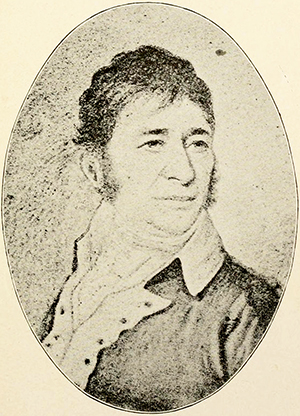22 Feb. 1757–13 Oct. 1807

Reading Blount was a major in the Continental Army during the American Revolution and an original member of the Society of the Cincinnati. He was the third son of Jacob Blount and his wife, Barbara Gray. Jacob was the son of Thomas Blount.
Reading was born at Blount Hall, the home of his father, which was located near Contentnea Creek in the New Bern District (now Pitt County). His mother died when he was six, and Jacob was remarried two years later to Hannah Salter. Jacob's sons were educated under Thomas Thomlinson, who opened a school in New Bern in 1764.
After news came of Lexington and Concord in 1775, the North Carolina assembly met in Hillsborough and divided the state into military districts. Reading Blount was commissioned a captain in the Third North Carolina Regiment on April 16, 1776. Blount was nineteen and his only previous military experience was drilling with the local militia. This regiment, which was accepted by Congress on May 7, 1776, was commanded by Colonel Jethro Sumner, whose daughter Mary ("Jackie") married Blount's younger brother Thomas. Captain Blount became a major on May 12, 1778. In June of that year he was transferred to the Fifth North Carolina Continental Line. On January 1, 1781, he was again transferred, this time to the First Continental Line. He served for nearly seven years.
At the Battle of Guilford Court House on March 15, 1781, Blount was cited for bravery. Again at the Battle of Eutaw Springs, on September 8, 1781, he was recognized by General Nathanael Greene for bravery beyond the call of duty. Military folklore alleges that through a misunderstanding of orders, a serious gap developed in the line of the Continental troops. Disaster seemed inevitable until the North Carolina battalion commanded by Ashe, Armstrong, and Blount maneuvered to avert catastrophe. General Greene stated that: "I was at a loss which most to admire—the gallantry of the officers or the good conduct of their men."
At the conclusion of the war, Blount returned to Blount Hall and became involved in the mercantile, shipping, land dealing, and other business interests of his relatives, John Gray and Thomas. He was briefly active in politics, serving a term in the legislature from Pitt County. For two or three years, he joined Thomas in Tarboro, where a branch of the Blount business was in operation. There he entertained President Washington when he came to Tarboro on his southern tour. But he found that he was not interested in selling sugar and salt, rum and hardware, nor in scouting the area for tobacco, corn, and forest products to ship. He absorbed the routines of farm, mill, and shop as a boy at Blount Hall, and he wanted primarily to be a planter.
Blount was nearly thirty-seven when he married Lucy Harvey, younger daughter of Colonel Miles Harvey of Perquimans County and granddaughter of Governor Thomas Harvey. Mary, Lucy's older half-sister, was already the wife of John Gray Blount. The wedding of Lucy and Reading took place in the John Gray Blount home in Washington on February 4, 1794. This house, built by John Gray Blount in 1778, was the sixth dwelling in the infant village at the Forks of the Tar and was occupied continuously by the Blount family until 1917. The house was demolished in 1923. John Gray Blount and his brother Bryan owned the Chocowinity Mills, opposite Washington on the Pamlico River, and he referred in deeds to this river location as his residence.
In 1796, Reading Blount bought three hundred acres of farm land on Tranter's Creek a few miles from Washington, on which there was a two-and-a-half-story house that he named "Bellefont." A feature of Bellefont, which is still standing after continuous occupancy for nearly two centuries, is a huge double-pent chimney, nineteen feet in width. This chimney has four fireplaces and four wardrobes constructed inside the chimney, each having an outside window.
This was Blount's home as he raised flax and wheat, continued his buying and selling of land, and engaged in extensive operations in the lumber industry. It was also the living space of his family and the area where the laborers he enslaved worked. He built another sawmill on Tranter's Creek in addition to the ones he already owned on Broad Creek and Pungo River.
In 1800, Blount was elected by the legislature to be major general of the First Division of Infantry of the state militia. Census records from the same year also denoted Blount's status as an enslaver. According to the 1800 Census, Blount enslaved 38 people.
Blount died at the age of fifty at Bellefont. In Lucy Harvey Blount's Bible is written, "Major Reading Blount, the husband of Lucy and father of her children died October 13, 1807 at 2 o'clock in the morning." Interment was the following day. However, because there was no Episcopal priest in the area, the funeral was not held until two months later. On December 8, 1807, family and friends met at the burying ground on the south side of the house to read the burial service and give him "the full honors of war."
Seven months after Blount's death, Lucy gave birth to his ninth child, and in February 1818, she was buried beside him at Bellefont. Several of their children are buried in this family cemetery, which is maintained by the Blount Family Society.